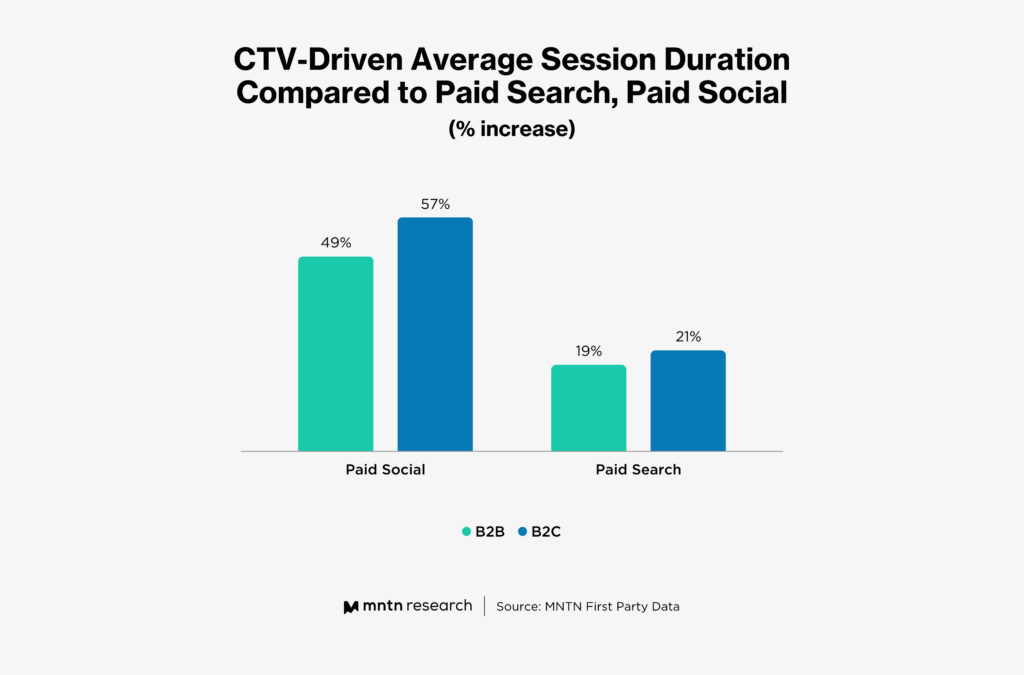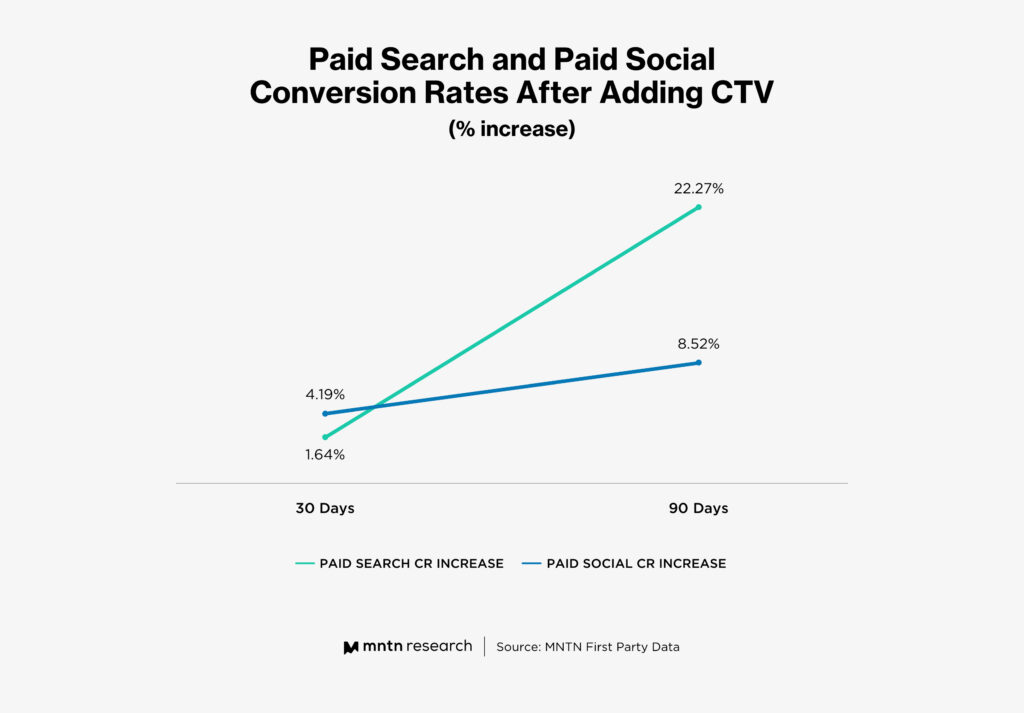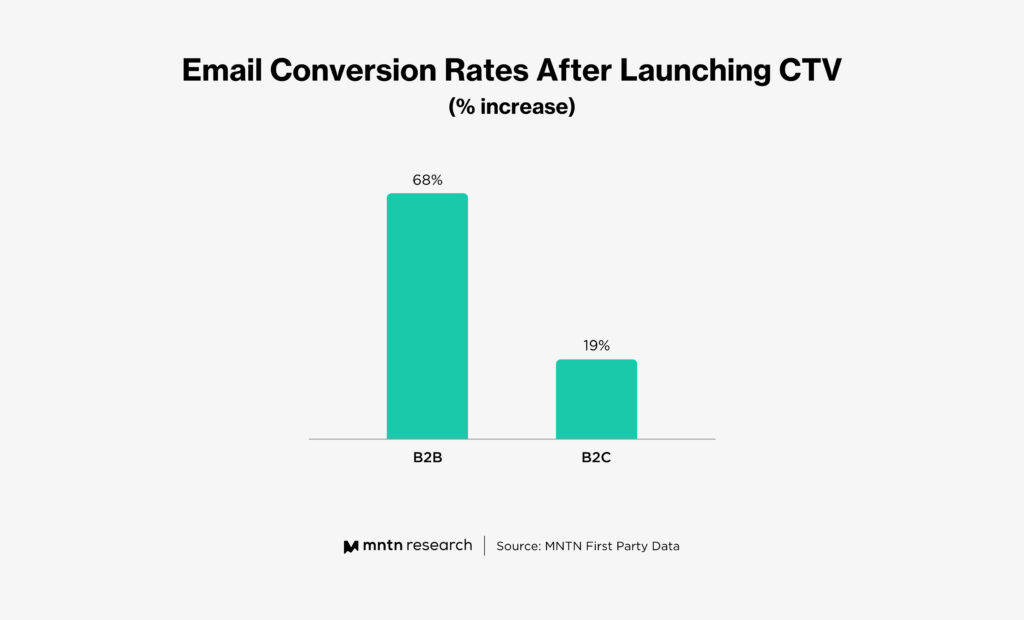Analysis
Connected TV Creates a Halo Effect For Paid Search and Social
by Isabel Greenfield6 min read
Abstract
- We looked at our first-party data from MNTN Performance TV to see the effects of adding CTV to an ad mix of paid search and social.
- We analyzed advertisers who were running paid search, paid social and Connected TV and looked at the performance of their paid channels before and after launching CTV.
- Connected TV drove a longer average session duration than both paid search and social across both B2C and B2B businesses.
- Conversion rates increased by 8.52% and 22.27% for paid social and paid search respectively 90 days after adding CTV to the ad mix.
- CTV also drove higher email conversion rates for both B2B and B2C brands.
Connected TV has stormed the scene over the past few years, becoming a high-impact and effective marketing touchpoint for advertisers. The sight, sound, and motion of the TV screen combined with the digital roots of paid search and social elevate TV advertising into a powerful tool for businesses of all sizes. With the right partner, CTV can transform the TV screen from a brand awareness play to a targeted performance marketing tool. The impact of CTV doesn’t stop there, however. It’s become an important part of the overall ad mix, creating a halo effect when run alongside paid search and paid social.
Halo Effect: The tendency for an impression created in one area to influence opinion [or performance] in another area.
Oxford Languages
We turned to our first-party data to look at advertisers who leveraged all three channels to examine the effects of adding CTV to an ad mix of paid search and paid social.

The data showed that Connected TV was generating more qualified site traffic compared to the other channels within the ad mix. Across both B2B and B2C advertisers, the average session duration was higher for those that visited after seeing a CTV ad rather than a paid search or social placement.
That doesn’t mean that CTV negates the need for paid search and social all together. Our data showed that if anything, adding CTV made paid search and paid social work harder. Conversion rates for both paid search and social rose just 30 days after advertisers added CTV to their ad mix and continued to rise significantly over the next 90 days.

This is the halo effect that Connected TV provides. Not only does it create a strong performance on its own, it elevates the other channels in the ad mix, boosting performance across the board.
Connected TV Creates Demand
Why exactly does Connected TV have this effect on the other channels? It comes down to demand generation. Paid search is great at capturing demand of people who are already actively searching for a product or service. It’s easy to identify these users as they are self-identifying. Yet this also creates increased competition as other businesses can just as easily target this same group. And eventually, that well will run dry; what happens after you’ve reached all the low-hanging fruit?
Connected TV on the other hand, not only captures existing demand, importantly it creates new demand. This combination makes it a valuable channel to diversify the ad mix. CTV is good at generating new demand for a few reasons:
- Those people viewing the ads are the right people. CTV’s audience and measurement capabilities let advertisers reach the people who would be interested in the product or service. After they are reached, their response can be measured.
- Ads are unskippable meaning that an advertiser’s full message is delivered to their intended target. Most people viewing these ads have decided that this is the content they want to watch and won’t be backing out to avoid a 15 or 30 second ad.
- With the right CTV partner, ads are only served on content streamed on the TV screen (not on a cell phone or tablet) and within brand-safe, high-quality content. At MNTN, we call this Living Room Quality, which refers to the TV viewer’s experience of watching TV in the comfort of their living rooms.
Connected TV is able to reach a key group of people: those that would be interested in the advertiser’s offer, but aren’t aware of it yet. This creates an awareness of the offering that paid search and paid social can then capture. Viewers are primed by the CTV ads and therefore more receptive to the paid search and social ads they view afterward. Based on our analysis, we even see this impact email conversion rates across both B2B and B2C customers.

CTV Boosts the Strengths of Paid Search and Social
Looking more closely at the comparison between CTV and paid search and social, some interesting trends start to appear that likely speak to the strengths of each channel within the ad mix.
When it comes to average session duration, Connected TV drove a bigger increase when it comes to paid social than paid search. A user served with a paid search ad is already in the discovery mode and is likely looking to research or buy; they are going to spend some time on an advertiser’s website. This isn’t necessarily true for a user served a paid social ad; they may not be currently looking to learn more, but advertisers are hoping to shift them into that mode. Connected TV does a better job at making this shift than paid social, driving significantly more time on site. And while the paid search numbers are smaller, it’s equally impressive that CTV still increases time spent compared to those who are already in discovery mode.
When it comes to conversion rates, the paid search and paid social numbers show the powerhouse effect of combining CTV with these strategies. The large effect it has on paid search shows that it’s priming the target audience to make it ready for a conversion once in the exploratory mode. And while social doesn’t always reach users at a time they are looking to convert, seeing a CTV ad first makes them more likely to do so.
CTV’s Auto-Optimization Adds to the Halo Effect
Another reason that our data showed these types of results is due to the focus on performance marketing and the auto-optimization that MNTN Performance TV offers. These CTV campaigns were run focusing on the advertiser’s key performance goals, unlike the broad awareness plays of CTV’s linear predecessor. MNTN’s platform also offers auto-optimization to ensure that the right audience is being reached to achieve the key KPIs of the campaign. When CTV is targeted in this way, it’s an effective tool that reaches the target audience most likely to convert and also elevates the other channels being run in conjunction.
Conclusion
Connected TV is an effective demand-generation tool that can be effectively optimized to reach an advertiser’s target demographic. It not only drives more qualified website traffic, but it also creates a halo effect for paid search and paid social, boosting conversion rates of both channels.
Subscribe to the MNTN Research Weekly
Sign up to receive a weekly feed of curated research, sent straight to your inbox.